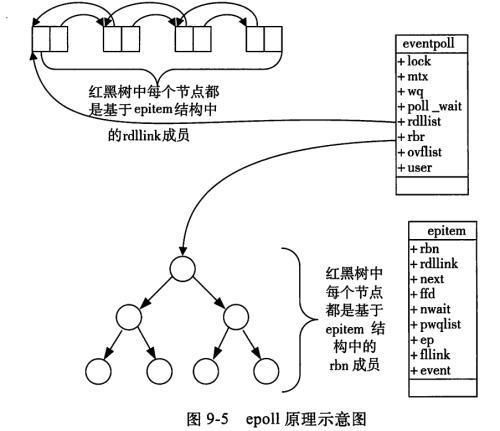Linux下Socket编程——epoll的使用
简介
- epoll与select
- epoll_create
- epoll_ctl
- epoll_wait
- ET、LT模式
#include
需要c/c++ Linux服务器高阶知识视频资料的朋友可以点击链接加入群聊【linux后台服务架构交流】
知识点有C/C++,Linux,golang技术,Nginx,ZeroMQ,MySQL,Redis,fastdfs,MongoDB,ZK,流媒体,CDN,P2P,K8S,Docker,TCP/IP,协程,DPDK等等。
给大家分享一个Linux下支撑亿级io的底层基石 epoll实战视频:
支撑亿级io的底层基石 epoll实战揭秘|epoll是什么?|epoll用在什么地方|项目实战|专业讲解|
epoll与select
- Epoll 没有最大并发连接的限制,上限是最大可以打开文件的数目
- 效率提升,epoll对于句柄事件的选择不是遍历的,是事件响应的,就是句柄上事件来就马上选择出来,不需要遍历整个句柄链表,因此效率非常高,内核将句柄用红黑树保存的,IO效率不随FD数目增加而线性下降。
- 内存拷贝, select让内核把 FD 消息通知给用户空间的时候使用了内存拷贝的方式,开销较大,但是Epoll 在这点上使用了共享内存的方式,这个内存拷贝也省略了。
相比于select,epoll最大的好处在于它不会随着监听fd数目的增长而降低效率。因为在内核中的select实现中,它是采用轮询来处理的,轮询的fd数目越多,自然耗时越多。 并且,在linux/posix_types.h头文件有这样的声明: #define __FD_SETSIZE 1024 表示select最多同时监听1024个fd,当然,可以通过修改头文件再重编译内核来扩大这个数目,但这似乎并不治本。
epoll_create
int epoll_create(int size);
创建一个epoll的句柄,
- size用来告诉内核这个监听的数目一共有多大。
这个参数不同于select()中的第一个参数,给出最大监听的fd+1的值。需要注意的是,当创建好epoll句柄后,它就是会占用一个fd值,在linux下如果查看/proc/进程id/fd/,是能够看到这个fd的,所以在使用完epoll后,必须调用close()关闭,否则可能导致fd被耗尽。
epoll_ctl
int epoll_ctl(int epfd, int op, int fd, struct epoll_event *event);
epoll的事件注册函数,它不同与select()是在监听事件时告诉内核要监听什么类型的事件,而是在这里先注册要监听的事件类型
- EPOLL_CTL_ADD 注册新的fd到epfd中;
- EPOLL_CTL_MOD 修改已经注册的fd的监听事件;
- EPOLL_CTL_DEL 从epfd中删除一个fd;
fd 是要监听的fd event 是要监听什么样的事件
typedef union epoll_data {
void *ptr;
int fd;
uint32_t u32;
uint64_t u64;
} epoll_data_t;
struct epoll_event {
uint32_t events; /* Epoll events */
epoll_data_t data; /* User data variable */
};
events可以是以下几个宏的集合:
- EPOLLIN :表示对应的文件描述符可以读(包括对端SOCKET正常关闭);
- EPOLLOUT:表示对应的文件描述符可以写;
- EPOLLPRI:表示对应的文件描述符有紧急的数据可读(这里应该表示有带外数据到来);
- EPOLLERR:表示对应的文件描述符发生错误;
- EPOLLHUP:表示对应的文件描述符被挂断;
- EPOLLET: 将EPOLL设为边缘触发(Edge Triggered)模式,这是相对于水平触发(Level Triggered)来说的。
- EPOLLONESHOT:只监听一次事件,当监听完这次事件之后,如果还需要继续监听这个socket的话,需要再次把这个socket加入到EPOLL队列里
epoll_wait
int epoll_wait(int epfd, struct epoll_event *events,
int maxevents, int timeout);
等待事件的产生,类似于select()调用。参数events用来从内核得到事件的集合,maxevents告之内核这个events有多大,这个 maxevents的值不能大于创建epoll_create()时的size,参数timeout是超时时间(毫秒,0会立即返回,-1将不确定,也有说法说是永久阻塞)。该函数返回需要处理的事件数目,如返回0表示已超时。
ET、LT两种工作模式:
- EPOLLLT:完全靠Linux-kernel-epoll驱动,应用程序只需要处理从epoll_wait返回的fds, 这些fds我们认为它们处于就绪状态。此时epoll可以认为是更快速的poll。
- EPOLLET:此模式下,系统仅仅通知应用程序哪些fds变成了就绪状态,一旦fd变成就绪状态,epoll将不再关注这个fd的任何状态信息(从epoll队列移除), 直到应用程序通过读写操作(非阻塞)触发EAGAIN状态,epoll认为这个fd又变为空闲状态,那么epoll又重新关注这个fd的状态变化(重新加入epoll队列)。 随着epoll_wait的返回,队列中的fds是在减少的,所以在大并发的系统中,EPOLLET更有优势,但是对程序员的要求也更高。
举例
假设现在对方发送了2k的数据,而我们先读取了1k,然后这时调用了epoll_wait,如果是边沿触发ET,那么这个fd变成就绪状态就会从epoll 队列移除,则epoll_wait 会一直阻塞,忽略尚未读取的1k数据; 而如果是水平触发LT,那么epoll_wait 还会检测到可读事件而返回,我们可以继续读取剩下的1k 数据。 总结: LT模式可能触发的次数更多, 一旦触发的次数多, 也就意味着效率会下降; 但这样也不能就说LT模式就比ET模式效率更低, 因为ET的使用对编程人员提出了更高更精细的要求,一旦使用者编程水平不够, 那ET模式还不如LT模式。
ET模式仅当状态发生变化的时候才获得通知,这里所谓的状态的变化并不包括缓冲区中还有未处理的数据,也就是说,如果要采用ET模式,需要一直read/write直到出错为止,很多人反映为什么采用ET模式只接收了一部分数据就再也得不到通知了,大多因为这样;而LT模式是只要有数据没有处理就会一直通知下去的.
epoll IO多路复用模型实现机制
设想一下如下场景:有100万个客户端同时与一个服务器进程保持着TCP连接。而每一时刻,通常只有几百上千个TCP连接是活跃的(事实上大部分场景都是这种情况)。如何实现这样的高并发? 在select/poll时代,服务器进程每次都把这100万个连接告诉操作系统(从用户态复制句柄数据结构到内核态),让操作系统内核去查询这些套接字上是否有事件发生,轮询完后,再将句柄数据复制到用户态,让服务器应用程序轮询处理已发生的网络事件,这一过程资源消耗较大,因此,select/poll一般只能处理几千的并发连接。 epoll的设计和实现与select完全不同。epoll通过在Linux内核中申请一个简易的文件系统,把原先的select/poll调用分成了3个部分:
- 调用epoll_create()建立一个epoll对象(在epoll文件系统中为这个句柄对象分配资源)
- 调用epoll_ctl向epoll对象中添加这100万个连接的套接字
- 调用epoll_wait收集发生的事件的连接
只需要在进程启动时建立一个epoll对象,然后在需要的时候向这个epoll对象中添加或者删除连接。同时,epoll_wait的效率也非常高,因为调用epoll_wait时,并没有一股脑的向操作系统复制这100万个连接的句柄数据,内核也不需要去遍历全部的连接。
Linux内核具体的epoll机制实现思路。
当某一进程调用epoll_create方法时,Linux内核会创建一个eventpoll结构体,这个结构体中有两个成员与epoll的使用方式密切相关
/*
* This structure is stored inside the "private_data" member of the file
* structure and rapresent the main data sructure for the eventpoll
* interface.
*/
struct eventpoll {
/* Protect the this structure access */
spinlock_t lock;
/*
* This mutex is used to ensure that files are not removed
* while epoll is using them. This is held during the event
* collection loop, the file cleanup path, the epoll file exit
* code and the ctl operations.
*/
struct mutex mtx;
/* Wait queue used by sys_epoll_wait() */
wait_queue_head_t wq;
/* Wait queue used by file->poll() */
wait_queue_head_t poll_wait;
/* List of ready file descriptors */
/*双链表中则存放着将要通过epoll_wait返回给用户的满足条件的事件*/
struct list_head rdllist;
/*红黑树的根节点,这颗树中存储着所有添加到epoll中的需要监控的事件*/
/* RB tree root used to store monitored fd structs */
struct rb_root rbr;
/*
* This is a single linked list that chains all the "struct epitem" that
* happened while transfering ready events to userspace w/out
* holding ->lock.
*/
struct epitem *ovflist;
/* The user that created the eventpoll descriptor */
struct user_struct *user;
};
每一个epoll对象都有一个独立的eventpoll结构体,用于存放通过epoll_ctl方法向epoll对象中添加进来的事件。这些事件都会挂载在红黑树中,如此,重复添加的事件就可以通过红黑树而高效的识别出来(红黑树的插入时间效率是lgn,其中n为树的高度)。
而所有添加到epoll中的事件都会与设备(网卡)驱动程序建立回调关系,也就是说,当相应的事件发生时会调用这个回调方法。这个回调方法在内核中叫ep_poll_callback,它会将发生的事件添加到rdlist双链表中。 在epoll中,对于每一个事件,都会建立一个epitem结构体,如下所示:
/*
* Each file descriptor added to the eventpoll interface will
* have an entry of this type linked to the "rbr" RB tree.
*/
struct epitem {
/* RB tree node used to link this structure to the eventpoll RB tree */
//红黑树节点
struct rb_node rbn;
/* List header used to link this structure to the eventpoll ready list */
//双向链表节点
struct list_head rdllink;
/*
* Works together "struct eventpoll"->ovflist in keeping the
* single linked chain of items.
*/
struct epitem *next;
/* The file descriptor information this item refers to */
//事件句柄信息
struct epoll_filefd ffd;
/* Number of active wait queue attached to poll operations */
int nwait;
/* List containing poll wait queues */
struct list_head pwqlist;
/* The "container" of this item */
//指向其所属的eventpoll对象
struct
![Uploading EPOLL_663944.jpg . . .]
eventpoll *ep;
/* List header used to link this item to the "struct file" items list */
struct list_head fllink;
/* The structure that describe the interested events and the source fd */
//期待发生的事件类型
struct epoll_event event;
};
当调用epoll_wait检查是否有事件发生时,只需要检查eventpoll对象中的rdlist双链表中是否有epitem元素即可。如果rdlist不为空,则把发生的事件复制到用户态,同时将事件数量返回给用户。
通过红黑树和双链表数据结构,并结合回调机制,造就了epoll的高效。


